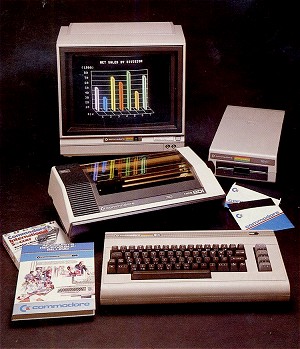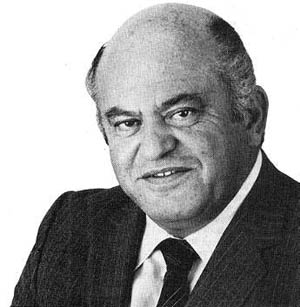Summary
The Commodore 64 (C64) is an 8-bit home computer released in August of 1982, and was the third system made by Commodore International. The starting price was $595 USD. The computer was named for its 64 kilobytes of RAM; superior to most mainstream personal computers at the time. The C64 is occasionally rendered: C=64 due to the original system's use of the "commodore symbol" which resembles a 'C' merged with an equal sign.
History
 Commodore 64
Commodore 64The Commodore 64 began development when Commodore Inc. bought MOS Technology. Unable to sell their technology in the mass market, MOS Tech approached Commodore in hopes of collaborating with their latest 6501 microprocessor. MOS had hoped to sell the microprocessor to console manufactures, but Commodore had other plans. MOS was also eager to sell their new SID sound chip in hopes that partnering with Commodore would give them an edge in the digital sound market. The iconic sound of the MOS SID chip was considered groundbreaking at the time, and video game sound composers used it to create entire in-game audio tracks.
 Jack Tramiel
Jack TramielJack Tramiel, founder of Commodore Business Machines, felt that the microprocessor was perfect for the new line of computers he had in mind. The chip would be the main microprocessor for the VIC-20.
The project was given to Commodore Japan; an engineering team led by Yash Terakura created the VIC-1001 for the Japanese market. The VIC-20 was marketed in Japan as VIC-1001 before VIC-20 was introduced to the US. The VIC-20 became a massive success.
Tramiel wanted to expand with the success of the VIC-20, but wanted a more powerful computer, while retaining a low price.
 Yash Terakura
Yash TerakuraCommodore began a game console/computer hybrid project that would use the new chips—called the Ultimax, or alternatively the Commodore MAX Machine, engineered by Yash Terakura from Commodore Japan. This project was eventually cancelled after just a few machines were manufactured for the Japanese market. The Commodore MAX hardware was the basis for the Commodore 64, and was the first computer of the C64 hardware family.
During the 1982 Consumer Electronics Show, the Commodore 64 was announced to enthusiasm. When the C64 was rolled out, it had an extremely low $595 price tag. Companies such as Intel and Atari had no idea how Commodore was making money on the computer. In reality, Commodore was using new and sometimes untested tech for their computer as opposed to licensing older tech from large competing corporations.
Reception and Market Share
 C64 Version of Karateka
C64 Version of KaratekaThroughout its 12 year lifespan, the C64 sold over 17 million units. As such, it remains one of the best-selling personal computer models of all time. From 1983-1985, the Commodore 64 dominated the personal computer market with a 40% share. It then went on to outsell former market leaders Apple and Intel, and led Commodore to winning the personal computer market war. Its successor, the Commodore 128, was released in 1985 and was fully backwards compatible with most C64 software but was far less successful than the C64.
In all, about 10,000 commercial software were made for the C64, including development tools, office applications, games, and more. The C64 is currently used by hobbyists, and C64 games are available for purchase on the Wii Shop Channel in Europe and the United States.
Hardware Specifications
- CPU: 8-bit MOS Technology 6510, 1.023 MHz
- Memory: 64KB RAM
- Graphics: MOS Technology VIC-II, 16 colors
- Sound: MOS Technology SID 6581/8580
SID Music
 SID 6581
SID 6581The Commodore 64's SID chip played a prominent role in the development of video game music, chiptunes, and the demo, crack, and warez scenes. SID (itself an acronym for Sound Interface Device) was created by Robert Yannes, an engineer who later moved to the synthesizer industry. Yannes stated that he felt previous computer sound chips had been designed by people who did not understand music, and sought to design a chip that would be useful for musicians. Previously, there had been a single chip for both audio and video, so a dedicated chip for audio provided musicians with much more freedom and range.
The initial run of the SID chip, the SID 6581, was extremely popular, and instrumental in the success of the Commodore 64. It allowed for much more freedom comparative to previous chips, such as three oscillators, each of which could produce four separate waveforms. Additionally, many composers were able to find loopholes to make their music even more complex, such as a glitch that essentially created a fourth channel for 4-bit samples. Some games that took advantage of this were Impossible Mission and Ghostbusters, both of which used voice samples.
 Many cracktros, such as this one, took advantage of the SID's capabilities
Many cracktros, such as this one, took advantage of the SID's capabilitiesMany well-known composers and developers had their start with the SID chip, such as Rob Hubbard and Martin Galway. These men have contributed to such games as Arkanoid, Wizball, Yie Ar Kung-Fu, Commando, Monty on the Run, and Skate or Die!. The composition process was initially very rough; composers would have to input a sequence of hexadecimal bytes where each line would describe the note, pitch, length, etc. of the sound being played.
By the mid-1980s, SID musicians were improving to a point where they could effectively emulate "real" music. Games such as Times of Lore were able to use mainstream songs as inspiration, and adapt that to a SID song. Also at this time, demo groups began to rise in popularity, with several Commodore 64 magazines releasing songs from their readers. The impact of SID music is evident as well, with songs still being developed to this day. While many musicians utilize emulation, some continue to use the original SID chips.
Log in to comment